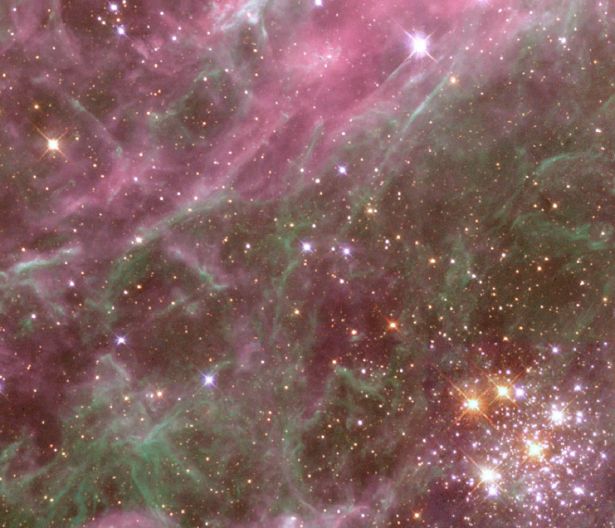
|
Explanation: The star cluster at lower right, cataloged as Hodge 301, is a denizen of the Tarantula Nebula. An evocative nebula in the southern sky, the sprawling cosmic Tarantula is an energetic star forming region some 168,000 light-years distant in our neighboring galaxy the Large Magellanic Cloud. The stars within Hodge 301 formed together tens of millions of years ago and as the massive ones quickly exhaust their nuclear fuel they explode. In fact, the red giant stars of Hodge 301 are rapidly approaching this violent final phase of stellar evolution - known as a supernova. These supernova blasts send material and shock waves back into the nebular gas to create the Tarantula's glowing filaments also visible in this Hubble Space Telescope Heritage image. But these spectacular stellar death explosions signal star birth as well, as the blast waves condense gas and dust to ultimately form the next generation of stars inside the Tarantula Nebula.
|
January February March April May June July August September October November December |
| ||||||||||||||||||||||||||||||||||||||||||||||||
NASA Web Site Statements, Warnings, and Disclaimers
NASA Official: Jay Norris. Specific rights apply.
A service of: LHEA at NASA / GSFC
& Michigan Tech. U.
Based on Astronomy Picture
Of the Day
Publications with keywords: supernova - star formation - LMC - Tarantula Nebula
Publications with words: supernova - star formation - LMC - Tarantula Nebula
See also:
- APOD: 2025 December 17 Á W5: The Soul Nebula
- APOD: 2025 December 9 Á The Heart of the Soul Nebula
- APOD: 2025 July 31 Á Supernova 2025rbs in NGC 7331
- APOD: 2025 July 10 Á Lynds Dark Nebula 1251
- APOD: 2025 June 23 Á W5: Pillars of Star Formation
- APOD: 2025 April 28 Á Gum 37 and the Southern Tadpoles
- APOD: 2025 March 26 Á Star Formation in the Pacman Nebula
